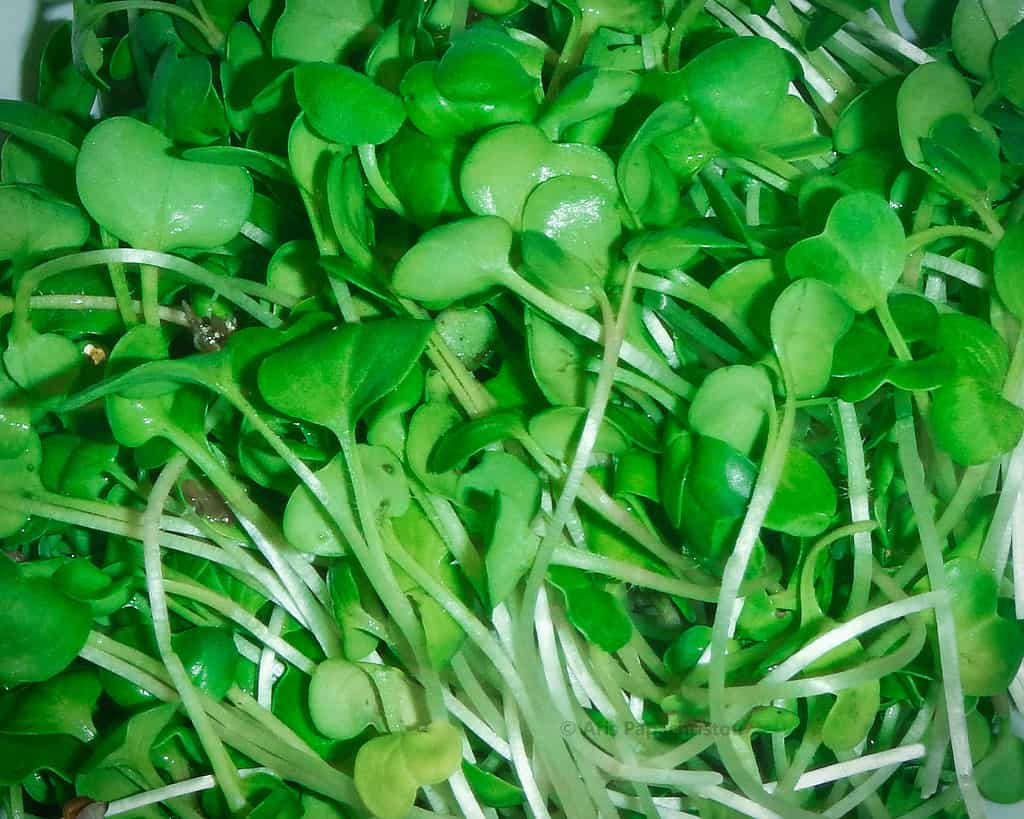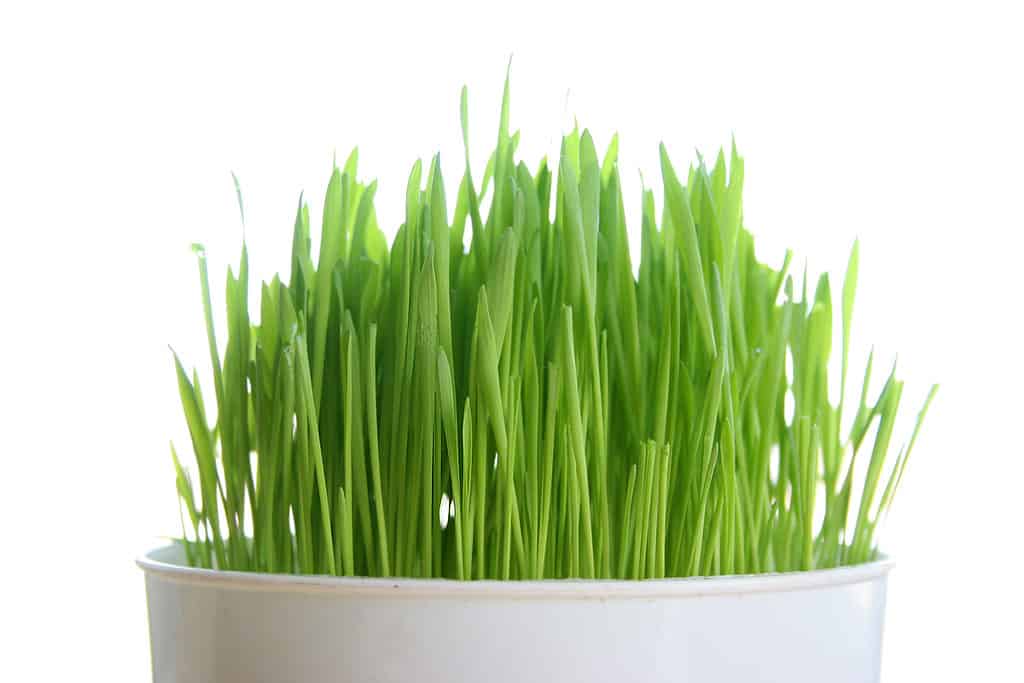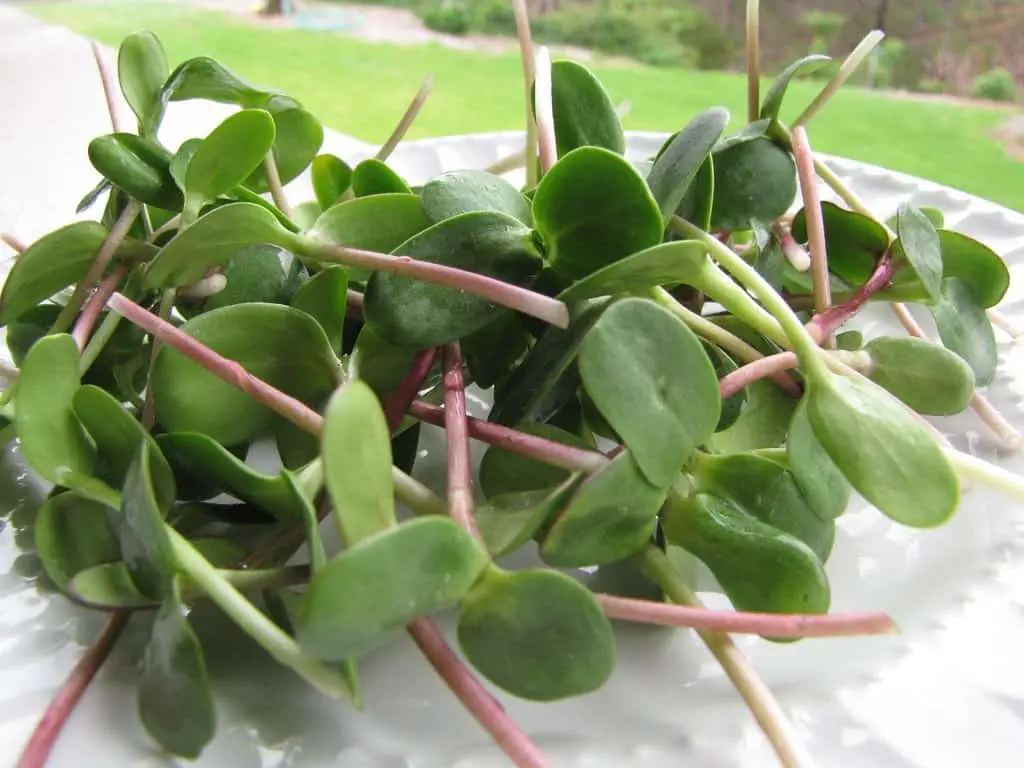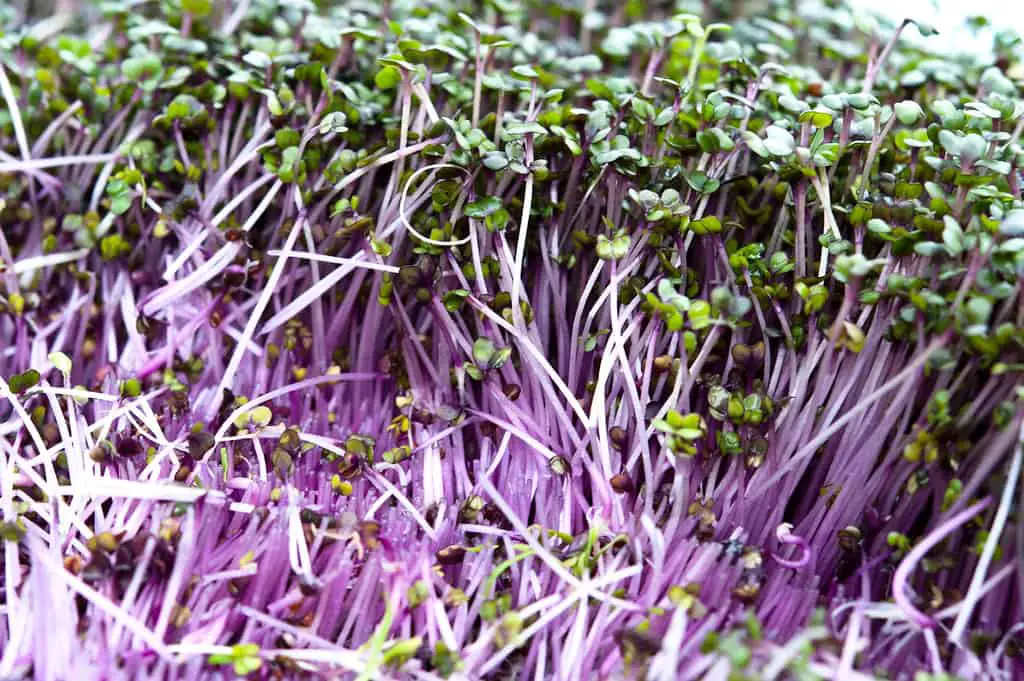Whether you have started your own business or are simply growing your own microgreens for fun, one of the major benefits of microgreen growing is that it only takes a few weeks to grow your own food! Although most microgreens grow faster than conventional crops, there are some types of microgreens that grow super fast. This blog post lists the fastest-growing microgreens and discusses how to grow each of them!
Radish Microgreens

Radish microgreens are probably my favorite type of microgreen. They are surprisingly spicy and are absolutely delicious on tacos and sandwiches. Radish microgreens are also easy to grow and are ready to harvest 8-12 days after sowing the seeds.
I have seen many sources that say you must soak radish microgreens prior to sowing the seeds. However, I have tried growing radish microgreens with soaked seeds and dry seeds. I did not notice a significant difference between the two harvests.
To learn more about growing radish microgreens, check out my article on how to grow radish microgreens.
Wheatgrass

Wheatgrass has become a very popular health food that can be added to juices and smoothies. I’ve always found it interesting that smoothie shops have a tray of what looks like grass sitting on their counters, but there is something nice about freshly harvested wheatgrass. You can actually create a similar experience at home. It is also worth noting that cats and dogs also benefit from munching on wheatgrass.
Wheatgrass is ready to harvest 8-10 days after sowing the seeds. The plants will be about 8 inches tall. I’ve seen articles that say wheatgrass can be ready in as little as 6 days if the conditions are just right. Access to plenty of sunlight is absolutely essential when growing wheatgrass. Otherwise, the wheatgrass will not develop a deep green color.
Before sowing wheatgrass seeds, it is important to soak them in water for 8-10 hours. Soaking helps with seed germination because moisture tells the seed that it is time to start growing.
Like some other types of microgreens, wheatgrass can regrow after cutting. However, the second harvest is not as nutritious and takes longer to grow.
Corn Shoots

Corn shoots are probably the fastest-growing microgreen type on this list. They are ready to harvest 6-8 days after sowing seeds. Corn shoots taste like very sweet, earthy corn. When I tried corn shoots, I was actually surprised at the sweetness and found it a bit difficult to use such sweet plants in my cooking.
In my opinion, growing corn shoots is one of the microgreens for science experiments and brand new growers. Although the flavor isn’t for everyone, you can actually grow corn shoots from popcorn kernels purchased at the supermarket rather than buying expensive seeds.
Another interesting aspect of growing corn shoots is that their entire growing cycle occurs in darkness. Lack of sunlight is what gives these plants their characteristic yellow color. Exposure to sunlight can also cause corn shoots to taste bitter rather than sweet. You also want to eat corn shoots fairly quickly because they become more bitter and tough as they mature.
For a step-by-step guide to growing corn shoots, check out the article I wrote about growing corn shoots.
Sunflower Microgreens

Sunflower microgreens are probably the most popular microgreen sold. They have a nutty, fresh flavor, and a delightful crunch that makes them a great addition to sandwiches, eggs, salads, smoothies, etc.
Sunflower microgreens are ready to harvest 7-10 days after sowing the seed. If you wait too long to harvest these microgreens, fuzzy shoots will begin to grow from the top of the microgreens. Although they are still edible, the fuzzy texture can be a bit off-putting (at least to me). Because sunflower microgreens grow from large seeds, it is important to soak the seeds for 8-12 hours before planting. This will significantly improve germination.
Not only are sunflower microgreens delicious, but they are also packed with nutrition. Research conducted by Dr. Qin Wang, who is an associate professor at the University of Maryland at College Park, found that microgreens are 4 to 40 times more concentrated with nutrients than their mature counterparts.
For a detailed guide of how to grow sunflower microgreens, check out my illustrated guide for growing sunflower microgreens.
Cabbage Microgreens

Cabbage microgreens are another type of microgreen that grows quickly and is fairly beginner-friendly. Cabbage microgreens are typically ready to harvest within 8-10 days of planting. Many other types of Brassica microgreens such as pak choi, mustard, and brussel sprouts are ready to harvest 8-12 days after sowing seeds.
Cabbage microgreens make a good addition to sandwiches and salads. They have a mild cabbage flavor which makes them particularly tasty on fish tacos and Asian dishes. Cabbage microgreens are also commonly used for garnishing dishes. Red cabbage microgreens are rather striking and make a good garnish.
Not only are cabbage microgreens delicious, they are good for you too! In 2016, researchers in Maryland used a rodent diet-induced obesity (DIO) model to determine that red cabbage microgreens may lower the risk of caridovascular disease by lowering cholesterol levels (Huang et al., 2016).
Unlike sunflower microgreens, you do not need to soak cabbage seeds prior to planting. Cabbage microgreens grow well in coco coir, soil, or a hydroponic growing medium. You will typically see germination after 2-3 days.
Microgreens That Take A Long Time To Grow
Some of the slowest-growing and most difficult microgreens to grow are as follows:
- Basil (12-18 days)
- Cilantro (21-28 days)
- Anise (7-20 days)
- Carrot (14-20 days)
- Thyme (5+ weeks)
Learn More About Growing Microgreens
Although this list talks about some microgreens that grow very quickly, there are numerous types of microgreens that you can grow at home! This is something that makes microgreen growing a fun hobby! To learn more about other types of microgreens, check out my article that discusses 101 types of microgreens that you can grow at home! This article includes a FREE digital download that tabulates information about each of the microgreens.
To learn more about successfully growing microgreens at home, check out my Ultimate Guide To Growing Microgreens. This blog post includes all of the information you need to get started growing microgreens.
